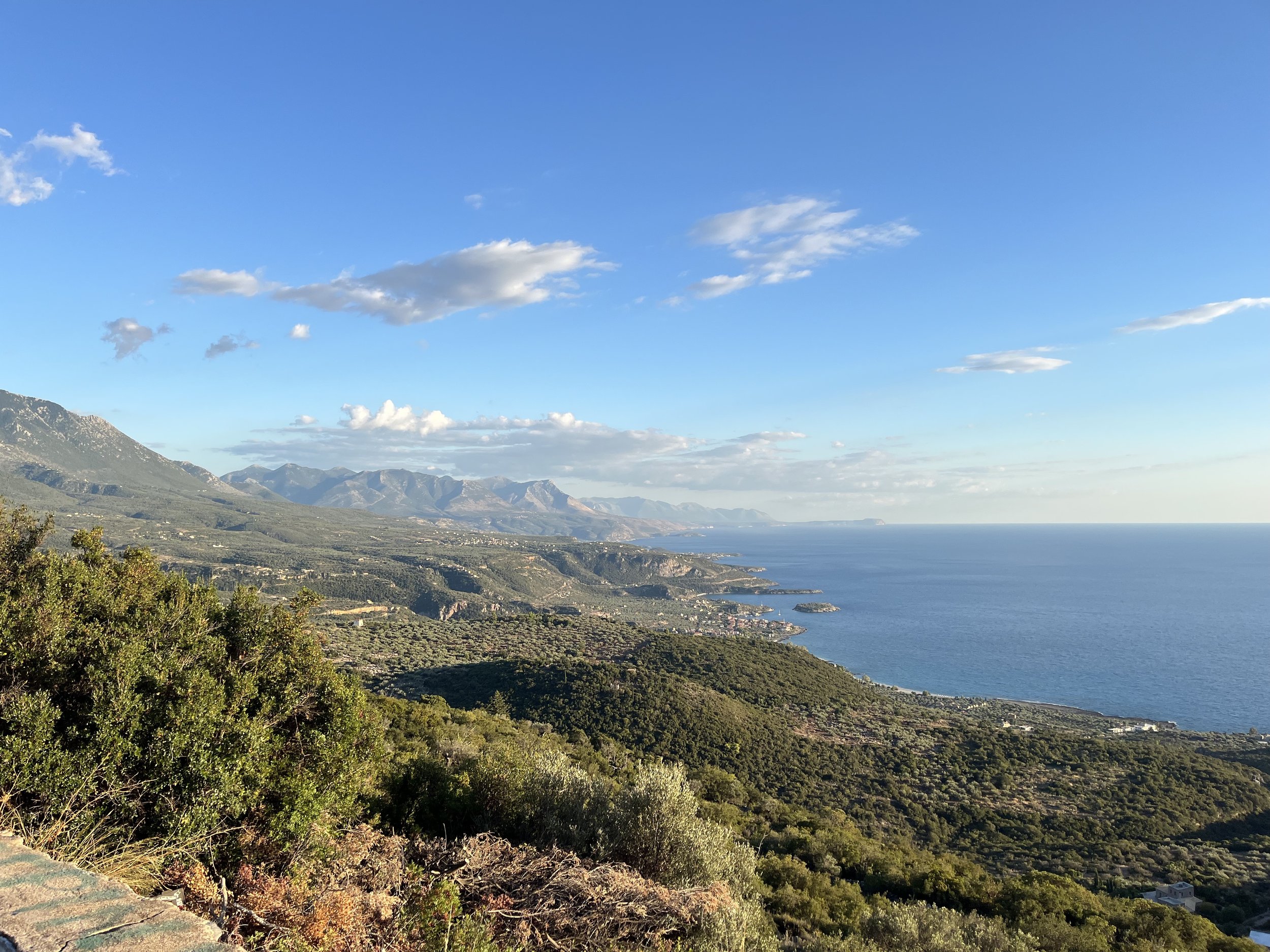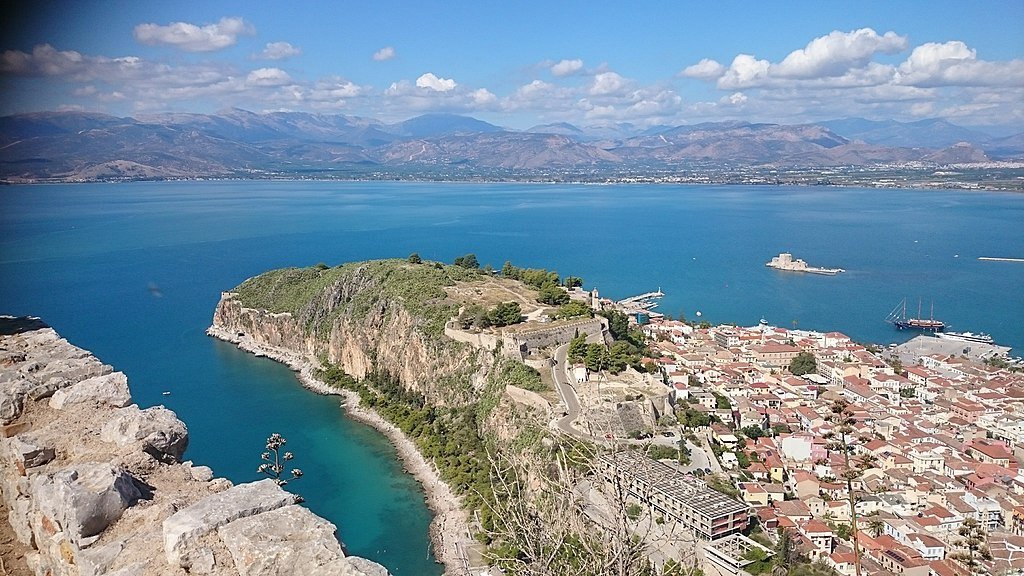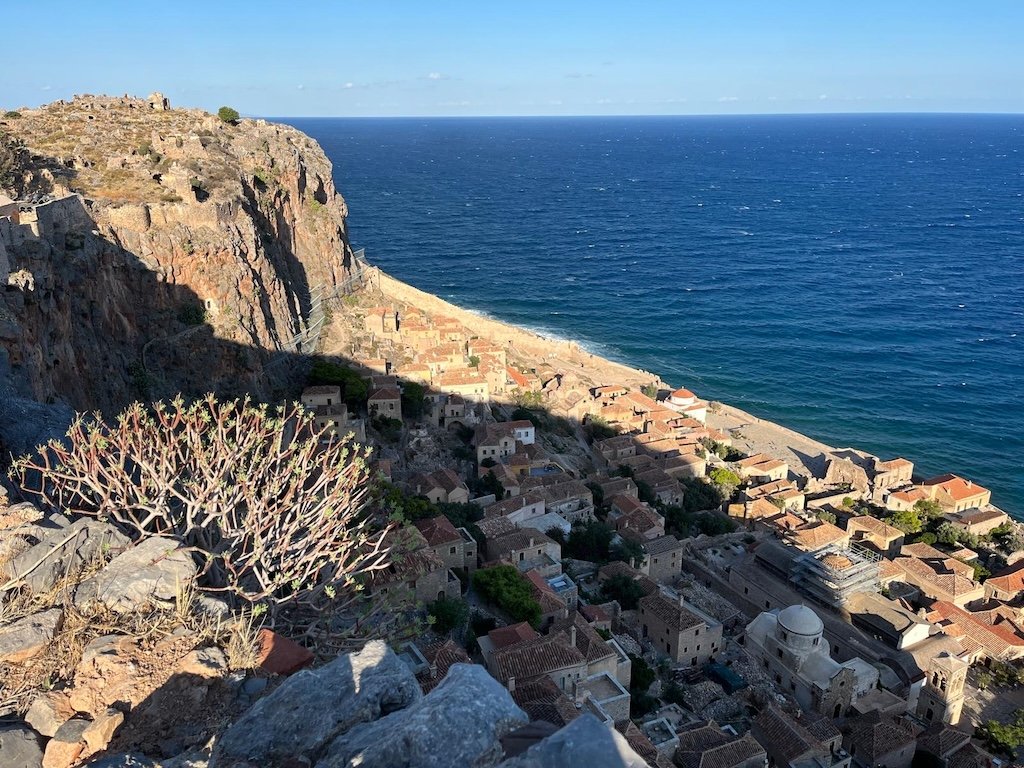A Local’s Guide to Travel in the Peloponnese, Greece
Affiliate disclosure: some of the links in this article are affiliate links. If you book using one of them, we’ll earn a small commission. All of our info is free to read and free of ads, so we appreciate it!
Nikos Kazantzakis, the famous Greek writer, called the Peloponnese ‘the ancient acropolis of all Greece’. This is a land that seemed impossibly old even to the ancient Greeks!
A place steeped in myths and legends, the Peloponnese is the epicenter of Greek mythology. Hercules and the god Hermes are said to have been born here. Jason and Medea lived in Corinth, also home of Sisyphus, Bellerophon, and Pegasus the flying horse. Arcadia was the homeland of goat-footed Pan.
The River Styx flows here, and if you go down to the southernmost tip of the Peloponnese, that’s where you’ll "find” the entrance to Hades, used by Hercules to drag out Cerberus, the hound of hell.
While these may be the people and places of stories, it all feels tangible when you’re standing there among the enormous boulders at the Lion Gate of the incredible archaeological site of Mycenae.
Along with its evocative archaeological sites, the natural beauty of the Peloponnese matches the high drama of its myths. The coastline boast some of Greece’s very best beaches, but be sure to pull yourself away from the sea and make time for walks in the countryside, where you’ll find myth-enchanted mountains, woodlands, gorges, lakes and rivers. These are the places that will stay in your mind and heart long after you’ve returned from your travels.
Table of Contents


What is the Peloponnese?
Photo: Pitichinaccio, recoloured by Ulamm 13:17, 20 January 2008 (UTC), CC BY-SA 3.0, via Wikimedia Commons
The Peloponnese is a large peninsula in the southernmost part of mainland Greece. If coming from Athens, the first city on the peninsula is Corinth, about 85 kms away - a 1-hour drive.
Much of the region is rugged and mountainous, particularly in its interior. The highest peak, the 2,405 meter Mount Taygetus, is in the south, but there are several other high mountains as well. They all trail into the Peloponnese’s four smaller peninsulas: the Argolid (near Athens), and the Messenian, Mani, and Cape Malea peninsulas in the south, which look a bit like three fingers.
The northern Peloponnese is the garden of Greece, lush with citrus groves and vineyards, which is a stark contrast to the arid Mani. There are important rivers, including the Alpheios (the ‘Alph, the sacred river’ in, Coleridge’s Kubla Khan), lakes, wetlands, and absolutely fantastic beaches of every description.
Administratively, the big peninsula is divided into seven regional units with names that recall the ancient city states that once held sway here: Corinthia, Achaia, Elis, Argolis, Arcadia, Laconia and Messenia. The mightiest was Laconia, the militaristic city state of Sparta.
Until the opening of the 6.3km (3.9 mile) Corinth Canal in 1893, the Peloponnese peninsula was linked by a narrow isthmus to the Greek mainland. The shape of the peninsula along with this narrow connection to the rest of Greece (now gone, due to the canal) strongly resembled a mulberry leaf dangling off of a branch, which inspired the region’s medieval name of Morea (‘mulberry’).
Why visit
The lovely town of Limeni
The coast near Nafplio
Monemvasia rock
The ancient theater at Epidaurus
Let’s start with the highlights: there are the fabulous beaches; five amazing UNESCO World Heritage Sites along with literally hundreds of relics of ancient cities and temples; impressive castles and Byzantine churches and monasteries; and gorgeous walled Venetian cities. But that’s far from everything.
The rest is Greece’s best kept secret: unspoiled landscapes to explore by foot, bike, or car; atmospheric villages and lively towns; l:akes and lake-filled caves; vineyards and endless olive groves; excellent tavernas, and most of all, the chance to experience ‘Old Greece’, before mass tourism took hold elsewhere in the country.
Every corner of the region has something to offer, and part of the fun is seeking out some of the lesser known attractions. One way to get started is with the excellent Topostext website, which pinpoints 950 ancient sites in the Peloponnese. Or take time to visit the kindly monks in the spectacular cliffside monasteries of Filosofou and Prodromou near Dimistana in Arcadia.
Taste the famous Tsakonian eggplants of Leonidio, on the east coast. Seek out the church inside the hollow of an enormous plane tree at Plataniotissa near Kalavryta. These are just a few of the many wonderful things to do here.
And the best part is that these wonders are never far away and there is an absurd abundance of them.
A bit of ancient history
Before talking about today's Peloponnese, I really must first [quickly] cover a few thousands years of ancient history. For a place that has been so important for world history and the development of western civilization, it would be an awful shame to just describe the pleasant towns and wonderful beaches of the region, and not also talk a little about its place in history. So here's my “elevator pitch”!
Peloponnesian history is as colorful and eventful as its myths. Mycenae was the powerhouse of Greece’s Bronze Age, while in historic times the cities of Corinth and Sparta were dominant regional forces. By Roman times, the Peloponnese, like the rest of Greece, had become a total backwater and stayed that way under the Byzantine empire.
After the Fourth Crusade led to the fall of Constantinople in 1204, the Crusaders conquered the region from Byzantines, calling it "Morea" Here, they built dozens of castles and made the peninsula into a province they called Achaea. Meanwhile, the Venetians occupied the ports they found useful.
The Byzantines eventually reclaimed most of the peninsula, creating the Despotate of Morea, which they ruled from the town of Mystras (which you can visit today). It endured as a western outpost of Byzantine culture until the Ottoman conquest in 1460.
The Ottomans ruled until the early 19th century, when the Peloponnese played a leading role in the Greek War of Independence, producing many of the leaders in the fight. The region then played host to the culminating victory of the war, with the Battle of Navarino in 1827. Full independence for the Peloponnese (and all of Greece) would follow a few years later.
How to get here
Located at the tip of the Balkans, the Peloponnese is the large southern peninsula of Greece, washed by the Gulf of Corinth to the north, the Ionian Sea to the west, and the Aegean Sea to the east and south.
It’s connected to Attica by bridges over the Corinth Canal, 77km from Athens. Trains on the suburban rail network (Proastiakos) from Athens International Airport and the port of Piraeus will take you as far as Aigio in the northern Peloponnese.
In the north of the region, the Rio-Antirrio bridge over the Gulf of Corinth links western mainland Greece to the suburbs of the city of Patras, which is also the port for ferries from Italy.
Kyllini, in the west, has links to the Ionian islands of Zakynthos and Kefalonia, while Gytheio, in the south, has ferries to the islands of Kythera and Crete.
Ferries and hydrofoils from various ports in the Argolis - Ermioni, Porto Cheli, Galatas, Methana, Nea Epidavuros - go to Piraeus and the Saronic islands of Aegina, Poros, Hydra and Spetses.
Kalamata in the southwest Peloponnese has an international airport, with numerous European connections during the busier times of year. There’s also a small airport at Araxos near Patras, with a few summer flights.
How to get around
While there are some old train lines throughout the region, they’re no longer used, which leaves buses as the main form of public transportation here.
The bus netowrk is actually pretty good, with connections to the main towns and cities fairly frequent and reliable. Where it starts to be less useful is when you want to go between little towns, out to the beaches, or into the mountains.
In general, if you're hoping to see a good bit of the region and hop between towns and beaches, you'll need to have your own car. If you're just coming to relax, visit a town or two, and lounge on the beach, you could get by with public transport.
If you’re planning on renting a car, I also always recommend checking prices on DiscoverCars. It’s a car rental website that includes offerings from all the major international rental companies as well as lots of smaller local agencies, which often have much better pricing.
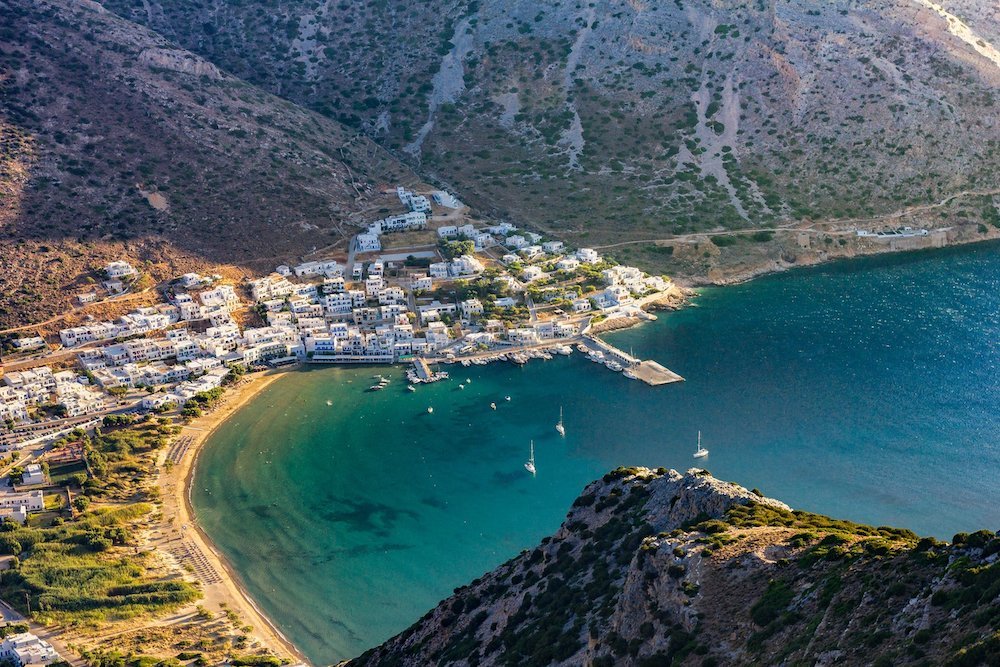
Cities and towns to visit
1. Nafplio
A view over Nafplio from atop Palamidi Castle. Photo: Girlyn_Mendoza, CC BY-SA 3.0, via Wikimedia Commons
Nafplio's harbor lit up in the evening. Photo: Holger Uwe Schmitt, CC BY-SA 4.0, via Wikimedia Commons. Cropped
In an exquisite setting, piled on the hillside overlooking the Saronic Gulf, Nafplio is one of the most beautiful towns in Greece. In ancient times the port of Mycenae, it briefly served as the capital of Greece in the 19th century before the government moved to Athens.
Colourful Venetian, Ottoman and Neoclassical house restaurants, bars and boutique hotels line the narrow streets around the charming main Syntagma Square; there’s also an excellent archaeology museum and nearby beach.
Floating high above is the vertiginous Palamidi Fortress, the last and by far most impressive fort built by the Venetians in the Peloponnese, some 857 steps up (there’s also a road). Another landmark is the Bourtzi, a little Venetian fort on an island that served as a retirement home for executioners in Ottoman times.
2. Patras
Patras seen from the town's castle. Photo: Conudrum, CC BY-SA 3.0, via Wikimedia Commons
Panachaiko mountain towering over Patras
Greece’s third largest city is a lively university town with enough sights to fill a day: an enormous archaeology museum, folklore museum, and castle with a Roman odeon tucked underneath.
The enormous cathedral of Agios Andreas,marks the spot where St Andrew was crucified on an X shaped cross before his body somehow ended up in Scotland. His head, however, has been here since Pope Paul VI returned it from Rome in 1964.
Views from the castle over the town and sea are great as are those in the opposite direction, from the marina up into the mountains.
Patras also boasts a lovely seaside park, with views of the mountains over the Gulf. Just northeast you can visit the Mycenaean Cemetery of Voudeni, while just southeast you can tour Greece’s oldest winery, Achaia Clauss, founded in 1861 by Gustav Clauss of Bavaria, with its old stone ‘wine castle’ and barrels of the estate’s famous sweet red Mavrodaphne.
3. Kalamata
The mountains outside of town seen from a park in Kalamata
Kalamata in the distance
The buzzing port city that has lent its name to the ubiquitous big fat purple olives has a long Blue Flag beach, and a handsome old town (the rest fell victim to an earthquake in 1986) around Vassileos Georgiou Square, where a fun crowd gathers every evening.
In terms of specific sights, the Frankish castle on top of the town survived the major earthquake in 1986 and provides some great views. The wonderful Victoria G. Karelias Collection is a museum dedicated to traditional Greek Costumes, and while that might sound kind of niche, it's really wonderful. There's also a very good archaeology museum in the town's former covered market.
There are several ways to delve into Kalamata’s olive and olive oil culture, including Kalamata Olive Tours in the nearby village of Sterna and the Olive Routes of Messenia.
4. Monemvasia
Monemvasia seen from the water
Monemvasia's old town seen from the top of the massif behind it
The Gibraltar of the Peloponnese, the huge rock on which Monemvasia sits split from the southeast coast in a mighty earthquake in 375 AD. Today, it’s linked to the mainland by a bridge, although no cars are allowed within the thick medieval walls.
The town has a maze of tiny pedestrian lanes lined with Byzantine and Venetian houses, along with a handful of churches, restaurants and bars, and a path leading up to the fortress on top of the rock.
Most people these days live in Gefira, the part of Monemvasia on the mainland, but it's the old town that's most of interest to visitors.
In the Middle Ages, this little town was known as the port of Mystras, and it was famous for the sale of white wine made from the grapes that took Monemvasia’s Venetian name - Malvasia.
5. Pylos
Pylos seen from across its marina. Photo: heipei from Deutschland, CC BY-SA 2.0, via Wikimedia Commons
A section of the Sikia channel outside of Pylos, where the legendary naval Battle of Navarino took place. Photo: Geoandrios, CC BY-SA 4.0, via Wikimedia Commons
In the large shady café-filled main square of Pylos is the great Monument to the Battle of Navarino, which took place here in 1827 that won Greece its independence from the Ottoman empire. The large hexagonal ‘New Castle’ overlooking town is one of the best preserved in the country, built by the Turks in 1573; inside is a church converted from a mosque and a fascinating museum.
With superb beaches, the Divari Pilou nature area, and Nestor’s Palace nearby, you could easily spend a couple of days.
6. Methoni and Koroni
Methoni castle. Photo: Spiros Paraskevopoulos, CC BY-SA 4.0, via Wikimedia Commons
The town of Koroni. Photo: Dnalor 01, CC BY-SA 3.0, via Wikimedia Commons
These two ports located on the southern tips of the Messenian peninsula, Methoni to the west and Koroni to the east, were nicknamed the ‘Eyes of the Republic’ back when Venice ruled the waves of the Eastern Mediterranean.
Both still have their Venetian-built castles. Steep Koroni, where driving is always an adventure, has one on top of town with tremendous views. Methoni, relatively flat, has a tremendously photogenic castle on a narrow peninsula, linked by a causeway with the mainland and with the isolated Boutzi, an octagonal Turkish fort.
Both towns have beaches and loads of old fashioned Greek charm.
7. Kardamyli
The coast around the town of Kardamyli (in the middle of the coastline). Photo: Tgvtornado, CC BY-SA 4.0, via Wikimedia Commons
The prettiest town in the Mani, Kardamyli is a symphony of stone and flowers (go in spring if you can!), overlooking an indented coastal landscape covered in olive groves and cypresses. There’s a fine clutch of 17th-century fortified towers from the golden age of Maniot feuds in Old Kardamyli, including the Mourtzinos Tower open to visitors as a museum of the Mani.
A path from here leads up towards the church of Agia Sophia past the legendary Mycenaean tombs of the Dioscuri, Castor and Pollux, the twin brothers of Helen of Troy—before descending into the beautiful Kardamyli Gorge.
Kardamyli was chosen by the famous travel writer Patrick Leigh Fermor and his wife Joan as the place to build their home by the sea. It’s now owned by the Benaki Museum in Athens, but to visit you need to book tickets online well in advance.
There’s a beach in walking distance of town, but prettier ones, Foneas and Delfinia, are tucked under the verdant hills just a little to the south.
Keep in mind, Kardamyli is absolutely tiny and a lot of the appeal of visiting is the splendid countryside and coast surrounding the the town.
8. Gytheio
Gythio's lovely waterfront
The other side of the waterfront
The port of ancient Sparta, cheerful Gytheio is the gateway to the Inner Mani (the wildest, arid easterly part of the peninsula), but like ancient Sparta itself, it has only a few vestiges of its important past: a small Roman theater and bits of the ancient Agora.
Gytheio’s landmark, the little islet of Kranae, now linked by a causeway to the mainland, has a lighthouse and castle of chieftain Tzanetakis; it’s also where Paris spent his first night with the beautiful Helen after abducting her and kicking off the Trojan War.
Gytheio is a busy resort town. Fishing boats bobbing the port bring in the day’s catch to the seaside tavernas and there are to a pair of nearby beaches: long sandy Mavrovouni Beach just to the south, and Selinitsa Beach just to the north, where the landmark is a rusty old freighter run aground.
9. Areopoli
A pretty square in Areopoli
A typical alley
Stone paths all over town
The name of this picturedque town means ‘city of Ares’ (the god of war), a name adopted in the 19th century in honor of local boy Petrobey Mavromichalis, one of the leaders from the Mani in Greece’s War of Independence. His bronze statue stands proud in the main square, Plateia Athanaton.
In the old part of town, the handsome church of the Taxiarchonis adorned with charming stone reliefs. Further on there are wonderful sea views from the cliffs.
Areopoli is within easy striking distance of the stunning watery stalactite caves of Dirou to the south, while just north, Petrobey’s tower-house still stands in the pretty seaside town of Limeni. There’s a lovely pebble beach nearby at Karavostasi.


Archaeological sites and ancient ruins
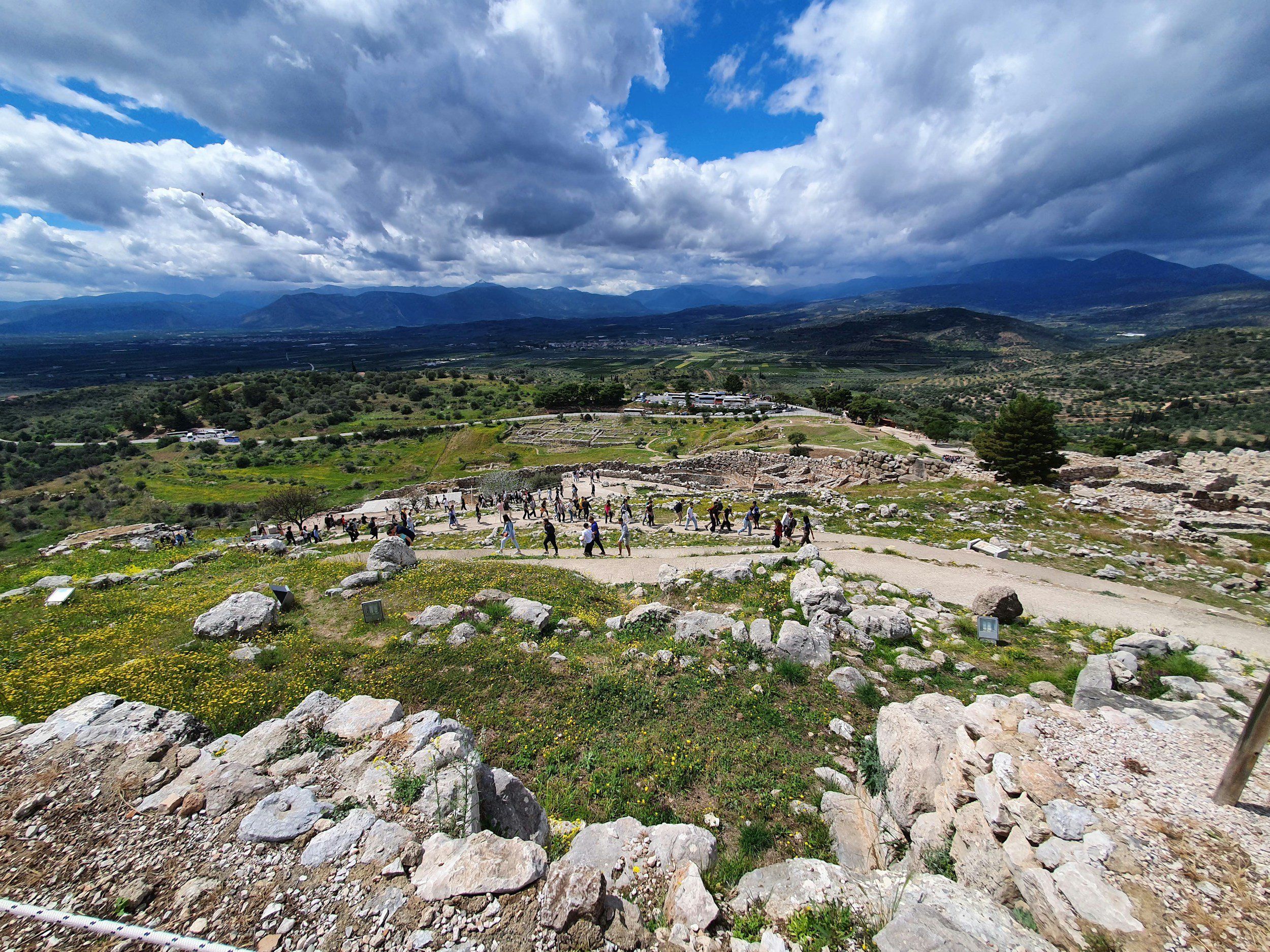

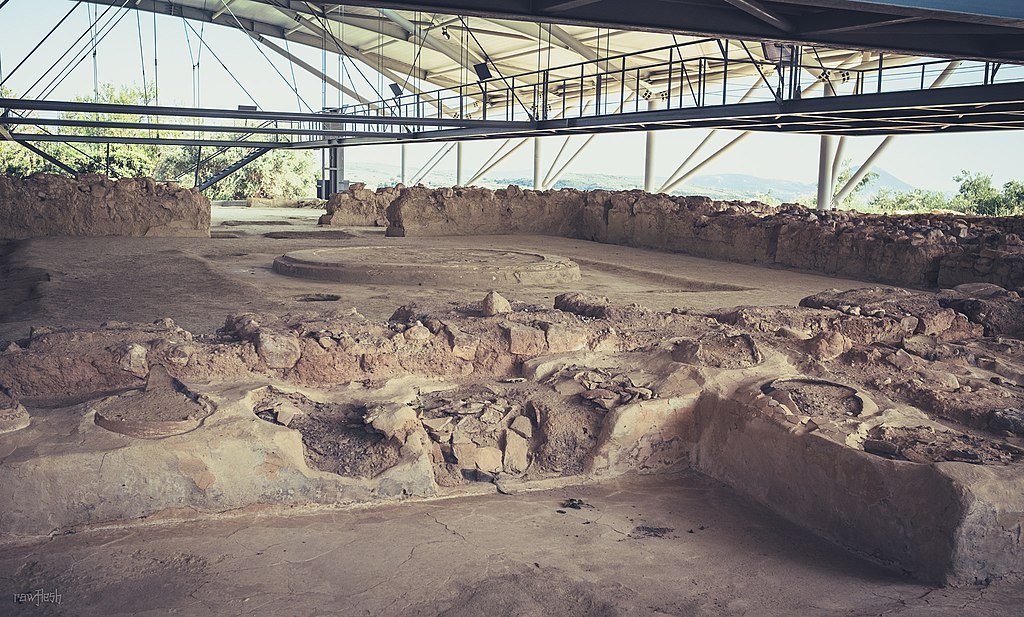
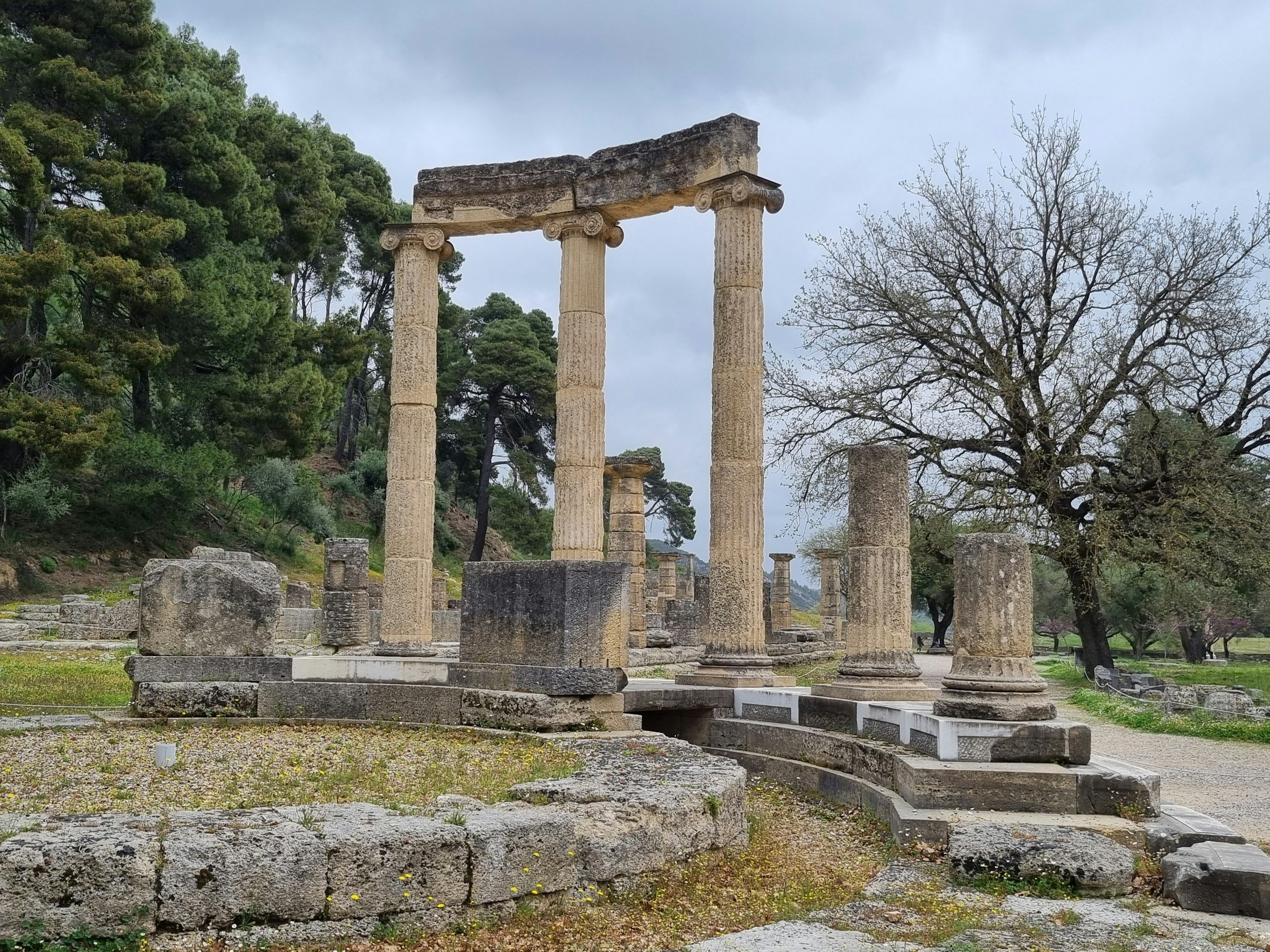
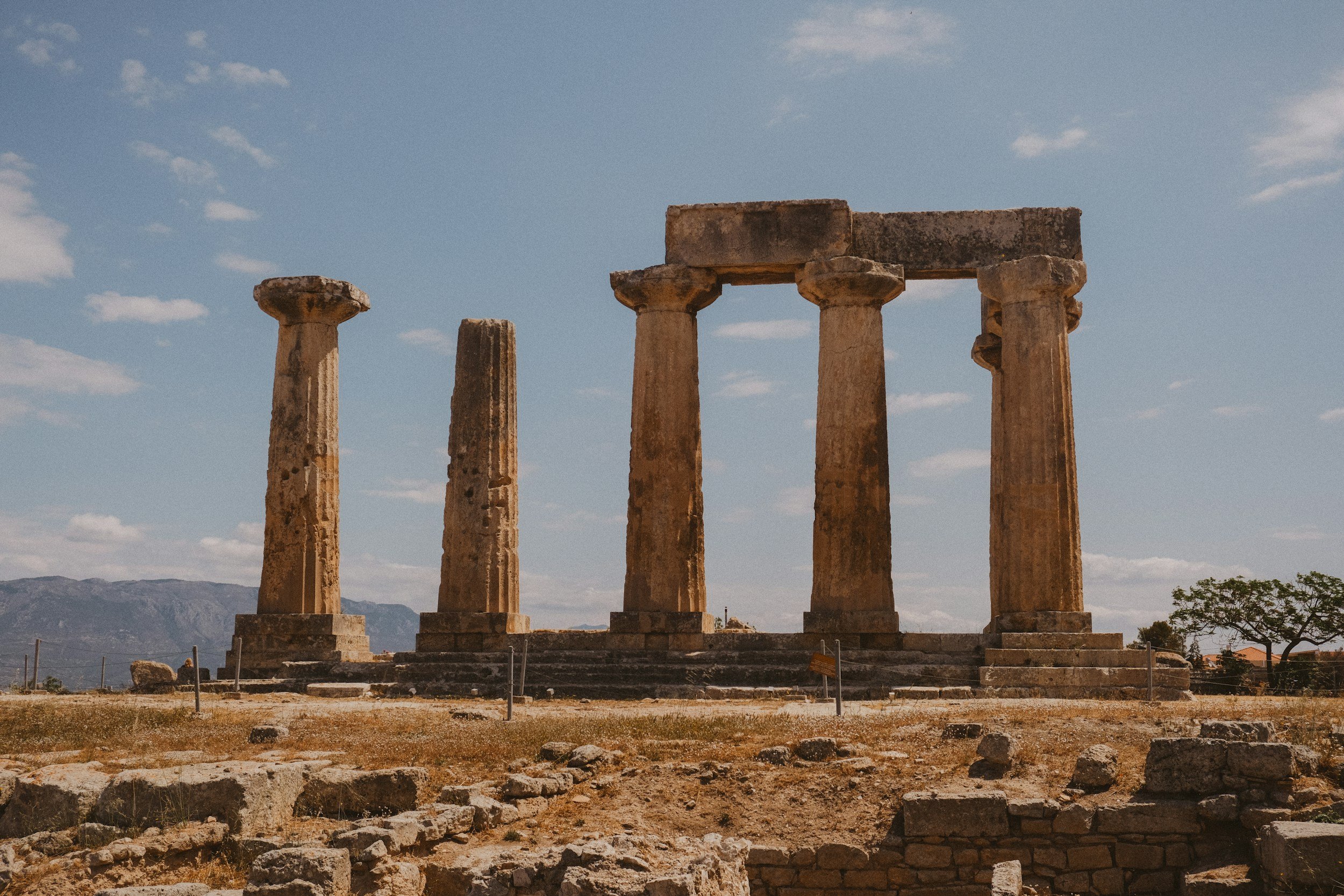
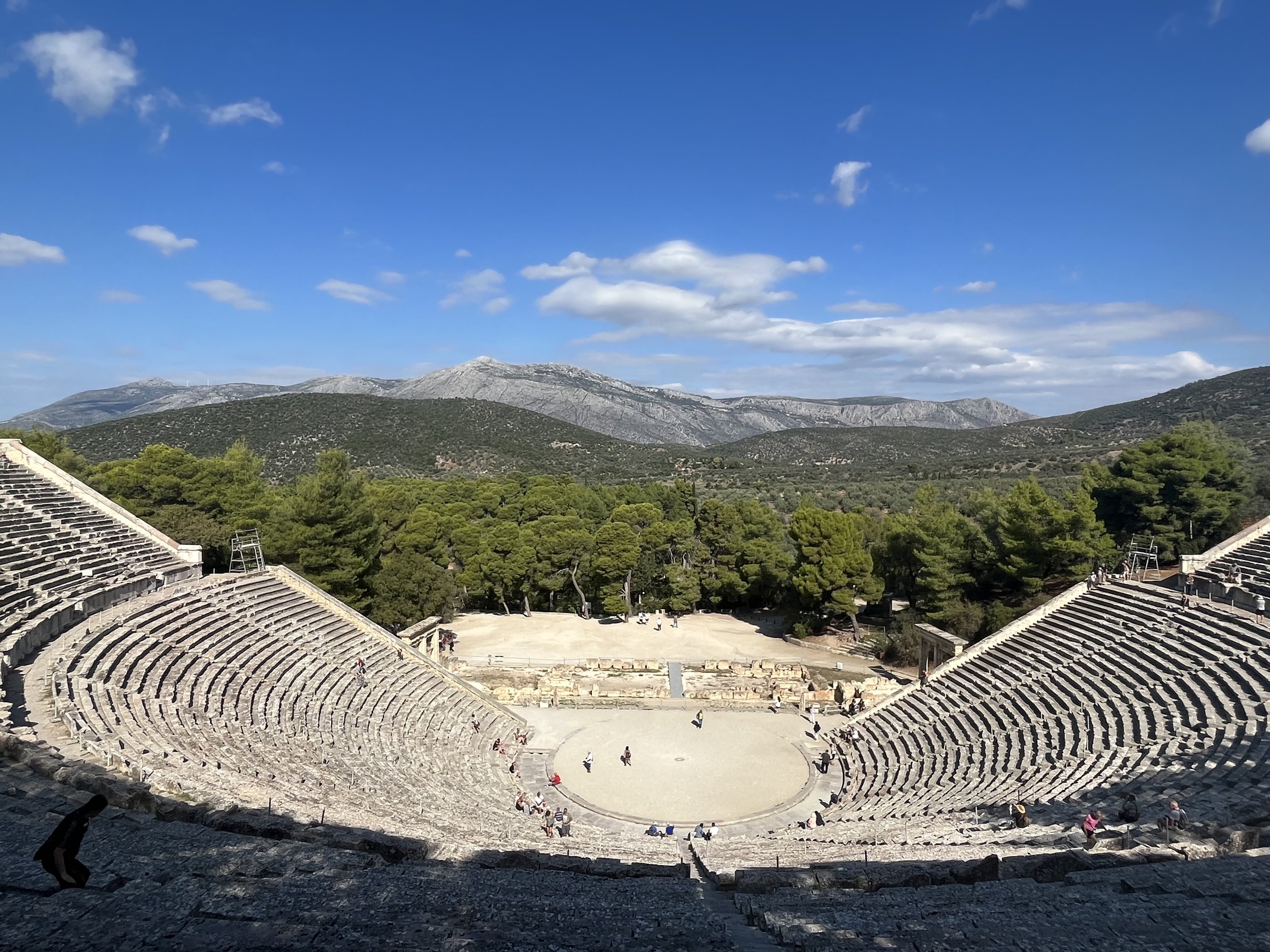
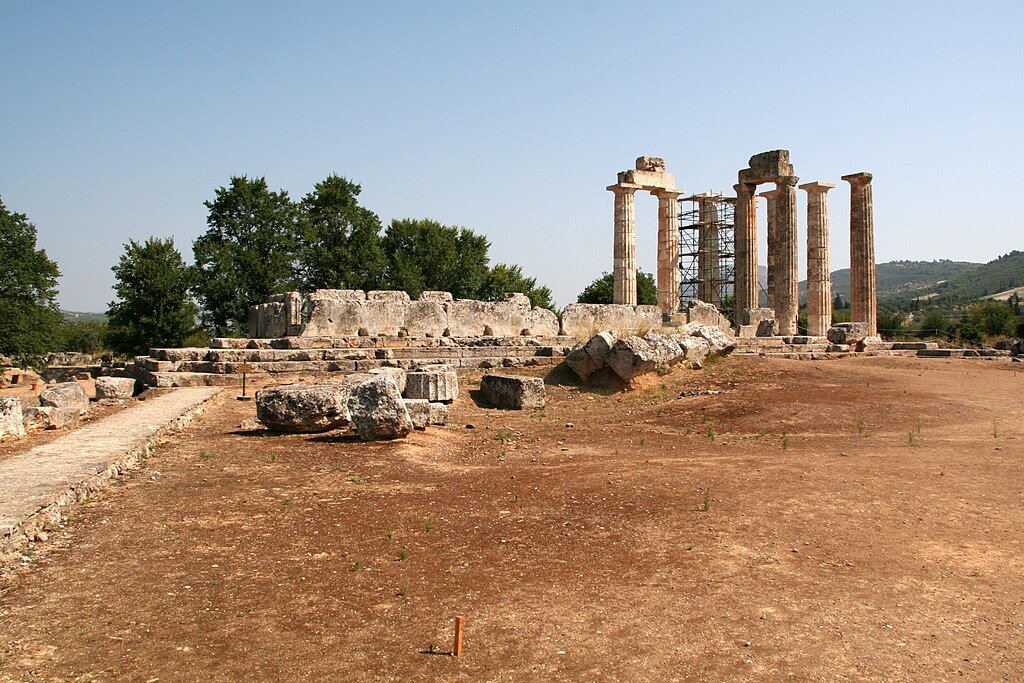
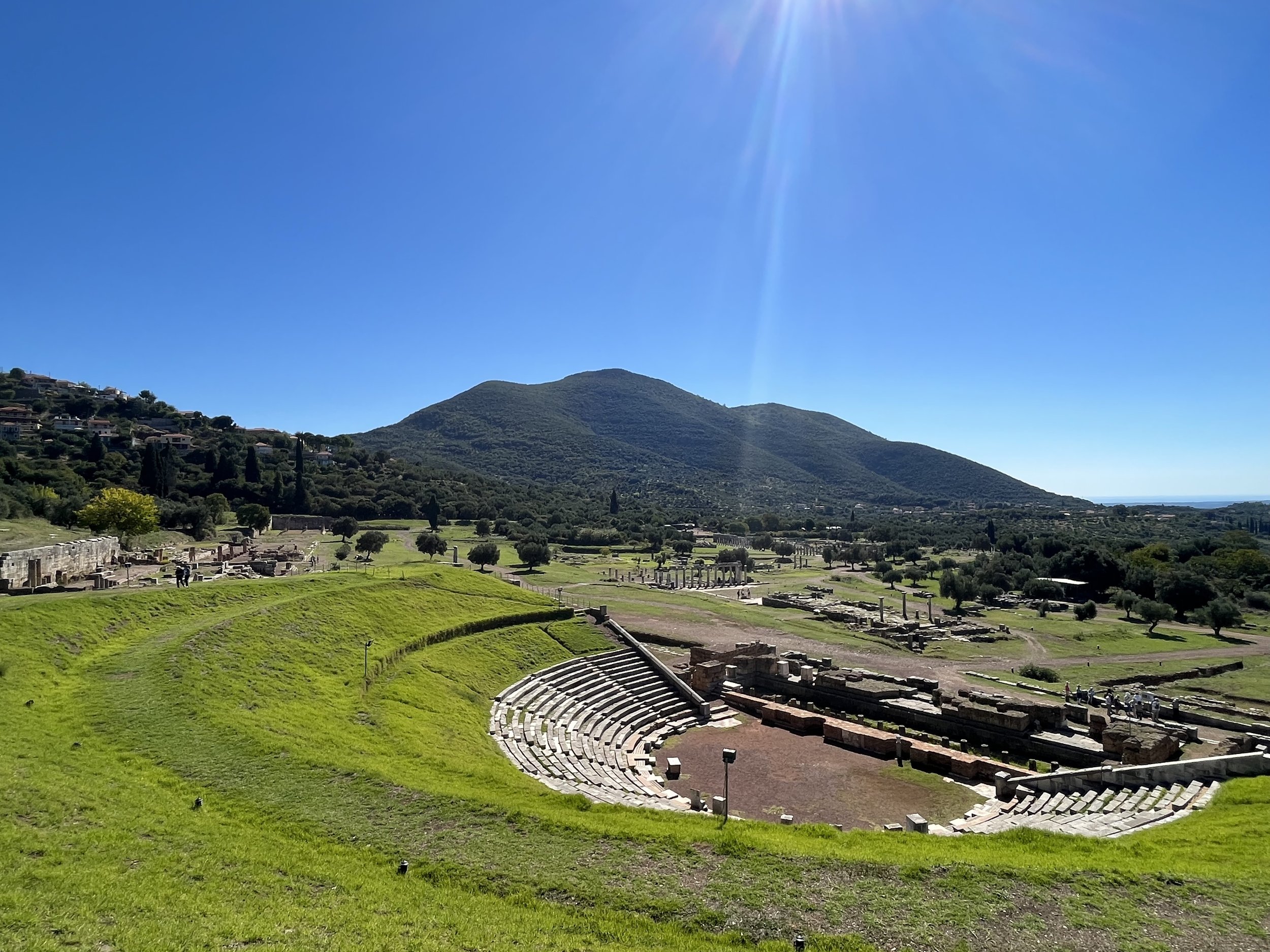
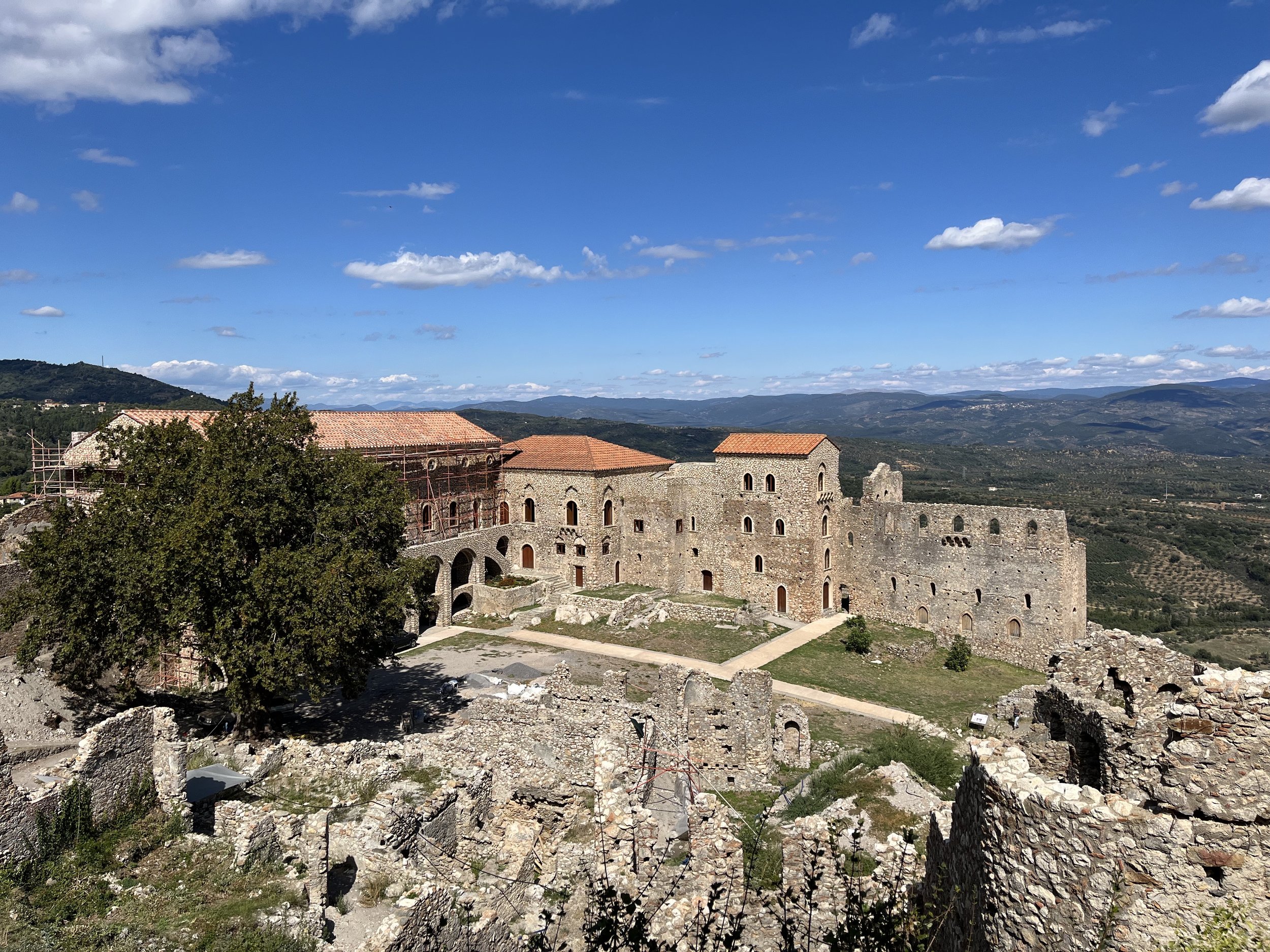
Much of what we know today about the Peloponnese’s archaeological sites comes from the 2nd century AD Description of Greece written by the travel writer Pausanias, who described dozens and dozens of ancient cities and temples.
Thankfully, many are still around and visitable. Here are what I consider the top 10 sites:
Mycenae
When Heinrich Schliemann discovered the citadel of Mycenae in 1874 and unearthed a golden mask from a tomb, he was certain that he was looking at the face of Agamemnon. And for the first time, people began to believe Homer’s Iliad was more than a good story. In fact, what Schliemann had discovered was older than the Trojan War, dating back to 1600 BC.
Walk up the long ramp of the citadel built of massive ‘Cyclopean’ boulders, each weighing an average of six tons, through the famous Lion Gate and up to the palace and tombs. The massive 48-ft tholos tomb nearby, known as the Treasury of Atreus as just as impressive.
Tiryns
Homer’s ‘wall-girt Tiryns’ 19km south of Mycenae, was the birthplace of Heracles, and the mighty Cyclopean walls around the acropolis are if anything even more impressive than those of Mycenae, although the modern surroundings lack Mycenae’s bleak, wild and lonesome atmosphere.
Walk through the Underground Casement Gallery—a corbelled corridor inside the walls, made of boulders polished over the centuries by the lanolin of sheep rubbing up against them; before Schliemann excavated the site, Tiryns has been used as a sheepfold.
Nestor’s Palace
Homer wrote of garrulous old Nestor. the ruler of ‘sandy Pylos’ in both the Iliad and the Odyssey, and in 1939 archaeologist Carl Blegen found his palace right where he thought it should be high on a commanding hilltop overlooking the sea, although he had to wait until after the war to excavate.
The most well preserved of Mycenaean royal palaces - even the bath tub remains in its original place - the Palace was built in 1300 BC but went up in flames a century after it was built, at the same time as Mycenae and Tiryns. A massive roof protects it from the elements.
Olympia
The first official Olympic Games took place in 776 BC in a wooded grove in Elis, in the west of the Peloponnese. The oldest and most important competition in the Greek world, they would take place every four years, when a truce would allow even enemies to compete in wrestling, footrace, boxing, and a sport that has yet to be revived: chariot racing, in ancient times the most prestigious of all.
Over the centuries Olympia became more and more elaborate: the archaeological site is chock full of temples and monuments along with the famous stadium, until it all ended in when the emperor Theodosius banned the games in 392 AD.
Today the torch for the modern Olympics is lit in the oldest building on the site: the Temple of Hera.
Ancient Corinth
This city on the isthmus was a popular stop for passing sailors, thanks to its temple of Armed Aphrodite and her sacred prostitutes, although they had to work to get there: the temple was on top of a 1,886ft monolith known as the Acrocorinth. When the Roman envoys came to call in 146 BC, the Corinthians tossed excrement on their heads. The Romans didn’t think it was funny and razed the city.
The Corinth rebuilt by Julius Caesar that hosted St Paul for 18 months in 51-52 AD is what you see today. The Acrocorinth, with its 3km of walls, went on to become the most important fortress in the Peloponnese. The views are spectacular if you make it to the top, but the sacred prostitutes are long gone.
Epidauros
Epidauros is synonymous with the world’s best preserved ancient theater, built in the 3rd century. Renowned for its near perfect acoustics, it can seat 12,000 and is still used in the summer Epidauros Festival.
Not as well known, perhaps, is that the theater was only part of an entertainment complex for the Asklepeion, one of the ancient Mediterranean’s top medical centers, the Mayo Clinic of its day, dedicated to the healing god Asklepios.
Along with the theater, its wealthy patrons contributed a large hotel, library, baths, stadium, gymnasium and an odeon (music hall) to the sanctuary; finds are in the site’s museum.
Nemea
The Olympic Games were the only most prestigious of the ancient Greece’s games. Nemea hosted biennial Games every other year in a stadium so well preserved that the Society for the Revival of the Nemean Games, founded in 1994, periodically stages ancient races here, awarding victors with traditional crown of wild celery.
One difference, however, is that today’s runners (there are races for men, women and children) wear chitons—in ancient times they were naked. There’s an excellent archaeology museum, too.
Temple of Apollo Epicurius at Bassae
This 5th-century BC temple, designed by Iktinos, the architect of the Parthenon, daringly combined the Doric and Ionic styles with the earliest known Corinthian capital. The temple would be better known if it weren’t isolated on a mountain...so isolated, in fact, it was forgotten for 1,700 years.
Commissioned by the ancient Figaleians to thank Apollo for averting the plague, it has been covered with a huge protective tent for decades, shielding it from the elements while awaiting a major restoration.
Messene
When the great Theban general Epaminondas finally defeated the Spartans in 371 BC, he founded the new city of Messene on the slopes of Mount Ithome and invited all the Messenian helots (who had been enslaved for centuries by the Spartans) and exiles to return to their newly independent city state.
Messene’s city walls, stretching 9 km (5.6 mi) long and mighty towers are surprisingly intact; the stadium, odeon, and many other monuments have been reconstructed, all in a splendid setting, yet it still remains something of a best-kept secret.
Mystras
In a garden setting, overlooking the lush Eurotas valley, Mystra was the capital of the Byzantine Despotate of the Morea in the 14th and 15th centuries—and a major centre of culture. The frescoes in its Byzantine churches are full of life and colour; the humanistic philosophy of Neoplatonist Gemistos Plethon would inspire the Renaissance in Florence.
A visit should always include the Despots’ Palace and if you have the energy, the hilltop Frankish castle, built by William Villehardouin in 1249.
Great beaches


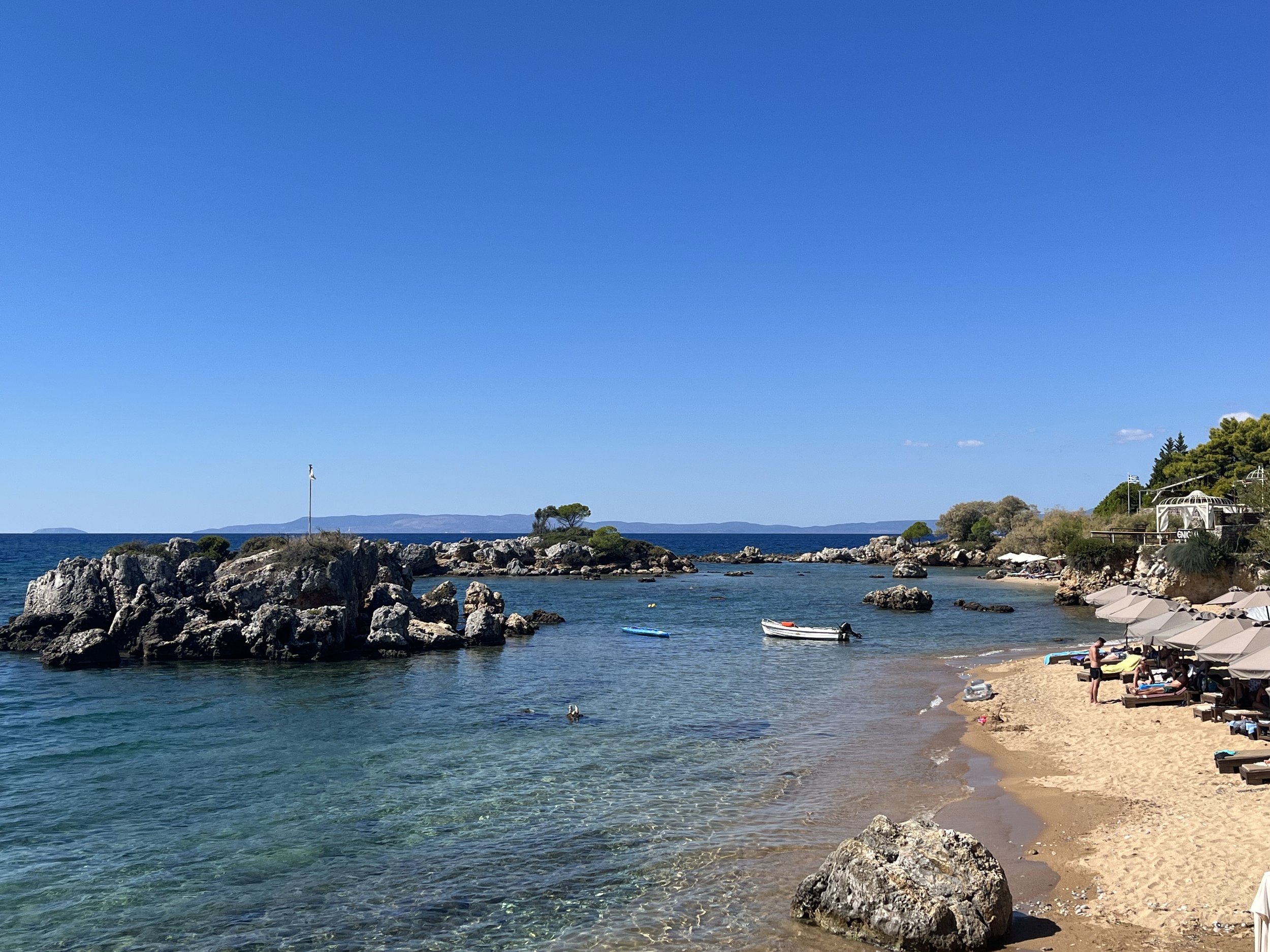
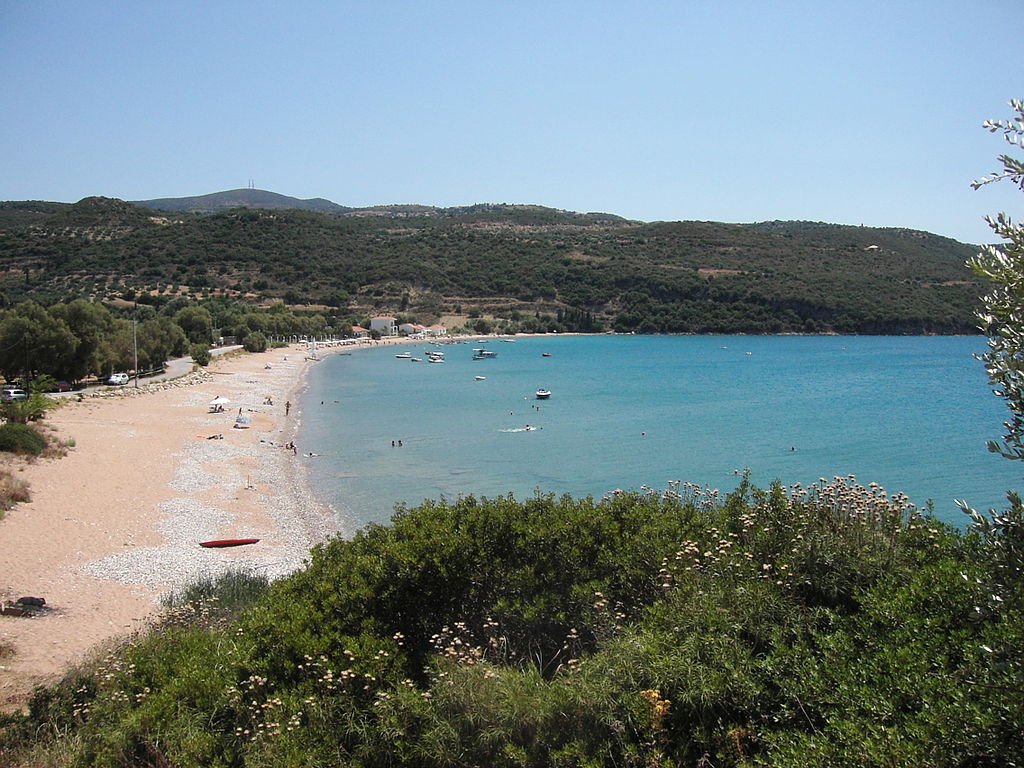
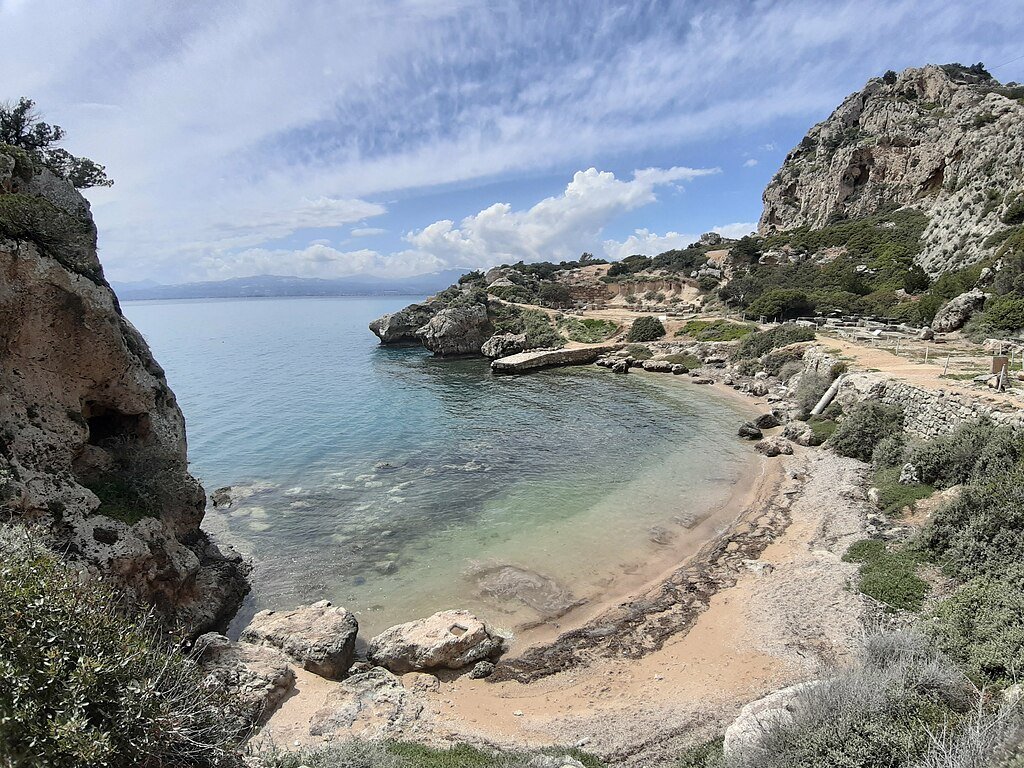
If you’re on a coast, you’re never far from a beach in the Peloponnese. Those with easy access tend to have at least a summer cantine offering drinks and snacks; the popular ones have sun beds, bars, tavernas, music, hotels, and campsites - the works.
Here are a few of my favorites:
Voidokilia
Located along the west coast, this near perfect omega-shaped circle of fine sand remains blessedly undeveloped because it’s part of the natural park, although it’s no secret so get there early or late in the day. Its name means ‘cow belly’ in Greek.
There are others nearby, including Romanos, Gialova, and the massive dunes of the Costa Navarino resort.
Simos
Off the Cape Malea peninsula, Elafonisos is a small island that broke away from the Peloponnese in an earthquake, but it’s close enough for a good swimmer to reach (there’s also a little ferry).
Here, Simos, a curling crescent of soft pinkish dunes shelving into a shallow turquoise sea, is a gem; if it’s too busy Elafonisos has several others nearly as wonderful.
Stoupa
This is the best known beach in the Mani, but the whole west coast of the peninsula is dotted with little coves, some sandy, some pebbly - the further south you go, the fewer the people you’ll have to share them with.
Trapeza
Located at Punta near Diakofto, this pebble beach is the most beautiful on the Gulf of Corinth. Set away from the busy coastal roads, it comes with plenty of facilities and enchanting views across the water towards the mountains around ancient Delphi.
Finikounda
Isolated on the south coast of Messenia’s peninsula, this town, named after its Phoenician founders, has long stretches of sand. Anemomilos Beach is especially renowned for the best wind surfing in the Peloponnese, and can supply all the equipment you need.
Perachora
Part of Corinth is located on the other side of the Corinth Canal, including this geographical poem of an archaeological site going back to the 7th century BC. It once held two famous temples dedicated to the goddess Hera, overlooking a curl of beach made for snorkeling; you can see the ruins of the ancient port when this sea is calm.
Astros
On the less visited east coast of the Peloponnese, Astros is a pretty village, perfect for a peaceful family holiday with a huge stretch of mostly sandy beach gently shelving into the sea. There are a few bars and sunbeds and food, perfect for a lazy day.
Vartholomio
Along a quiet stretch of west coast south of Kyllini, these seemingly endless sands on the Ionian sea are never crowded. Part of the beach is organized, much of it is not, and the sunsets are pure magic.
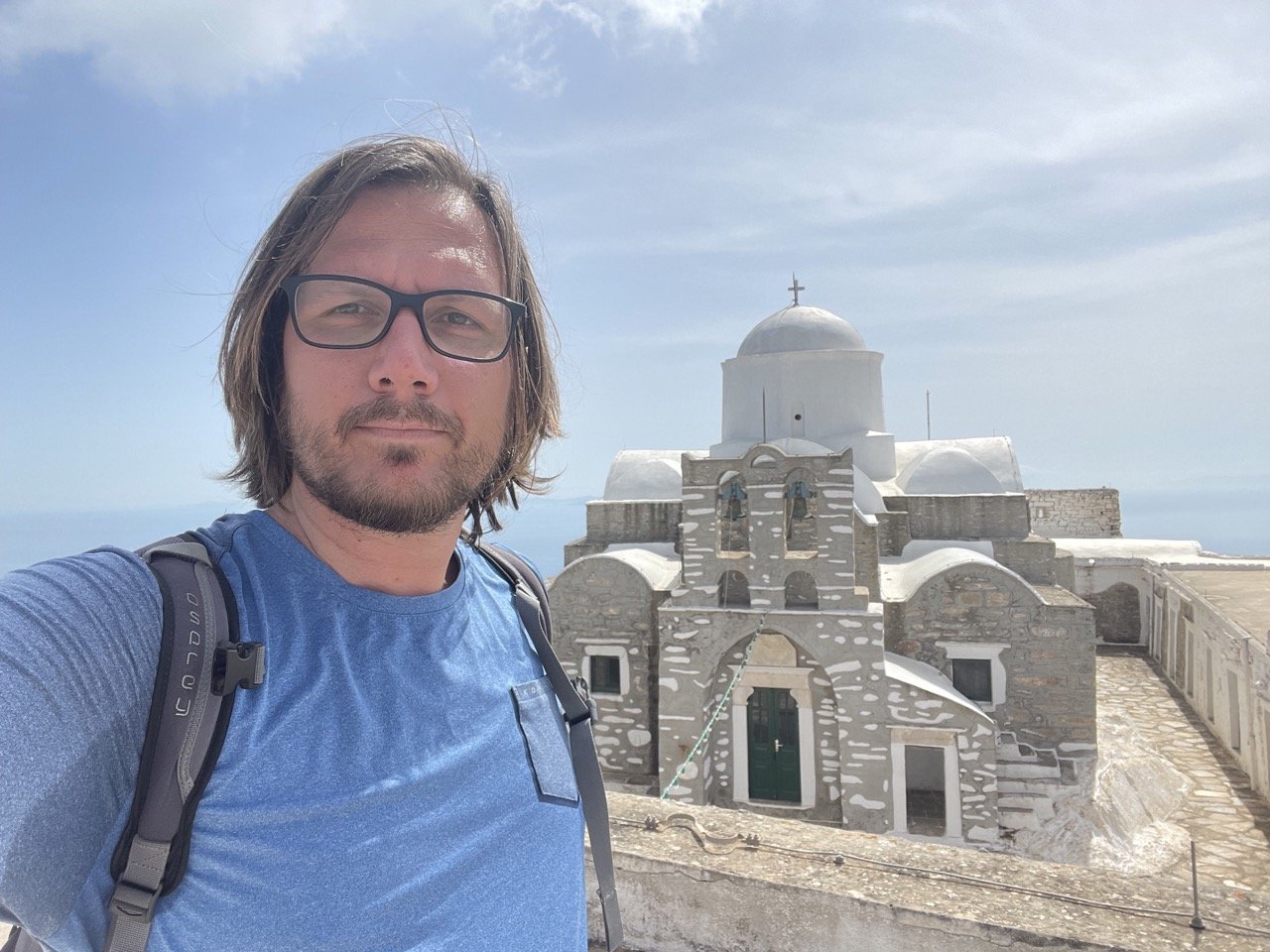

How long to spend
The Peloponnese is larger than most people realize, so it's not somewhere that you can realistically visit as just a quick “add on” to a stay in Athens. For a first visit covering the highlights, you need a bare minimum of 5 days, with a week being ideal. You could easily spend much more time than that too.
To give you an idea of its size, the Peloponnese covers 8,320 square miles and it’s roughly 160 miles from the Corinth Canal to the tip of the Mani peninsula in the south - although the terrain is very mountainous, so it feels bigger.
That said, there are speedy toll highways across the north from Corinth to Patras (80 miles and about 1.5 hours) and from Corinth south to Kalamata (100 miles and just under 2 hours), making some cross-region trips quick and easy.
If time is short and you want to concentrate on the star attractions, many are concentrated in the Argolis peninsula in the far northeast, which also has the advantage of being close to Athens and boasts some pretty beaches.
Another major center is the southwest around Kalamata and its sea of olive groves. The city is located between the two peninsulas of the Mani and Messene, which is where you’ll find ancient cities, castles, and fine beaches.
Ancient Olympia, in the west, is another key point of interest, with fascinating mountain villages and hiking trails just to the south and east.
Weather & when to visit
Visiting in Spring
The Peloponnese is at its most delightful in the spring, from March to late May. It’s not too hot, temperatures are ideal for hiking or biking, and it’s unusually warm enough to sit out most evenings for dinner.
Wildflowers cover the countryside; rivers and waterfalls are sparkling; you can doze on the beach and maybe even pop in for a dip. The summer crowd have yet to come, yet everything is open.
If you’re here for Greek Easter, head to the east coast town of Leonidio, where they celebrate by sending up hundreds of paper balloons at Easter midnight.
Visiting in Summer
Summers, as in the rest of Greece, are the top tourist season. It often be quite hot by the sea—often in the high 30sC (98--102F) even although you can always escape into the cooler realms of the mountains, which are never far.
The most popular destinations will be crowded, but this is also the time of festivals, of saint’s day celebrations in the villages (panigyri) as well as Kalamata’s International Dance festival, the Nafplio Music Festival, the Epidaurus Festival of Ancient Greek theatre and the historic Tegea Fair.
Visiting in Fall
Fall is colourful, in the vineyards and forests, and brings cooler weather, making it another perfect time for hiking, swimming and touring without the crowds. But it may well rain!
Late September is the time of the Spartathlon, the 245km extreme footrace from Sparta to Athens, retracing the steps of Pheidippides in 490BC (the Athenians sent him to tell the Spartans the Persians were invading at Marathon but the Spartans replied “sorry, can’t help; we’re having a festival”).
On 20 October Pylos celebrates the Battle of Navarino, when yachts and battleships moor in the harbour for the festivities.
Visiting in Winter
In winter, the major archaeological sites and museums are open, and you may well have them to yourself. The resorts are closed and days are short, but you’ll find hotels to stay in the cities, or maybe a cosy little xenonas (guesthouse) in the mountains, especially where it’s likely to snow. These are very popular with Greeks, especially during the Christmas holidays.
You can even indulge in some winter sports at the ski centers at Mailano, Kalavrita and Ziria. The late winter Carnival in Patras is the biggest in Greece.
Where to base yourself
If you’re looking to cover large swathes of territory and do a lot of sightseeing without driving many hours every day, you’ll need to move regularly, staying in different locations every night or two. The Peloponnese is just too big to explore from one or two bases.
With that in mind, these are my recommendations for regional hubs:
Tripoli
If you want a central base, the regional capital of Tripoli, sitting in the middle of the big peninsula at the intersection of two main highways, is the logical choice. It’s a lively city, but don’t expect any charm. You certainly won’t see many fellow tourists.
Kalamata
If you’re focusing on the south, Kalamata with its airport, is a good option. The city itself is not very touristy, has a long beach and promenade, buzzing nightlife, and offers easy access to the sights on the Messenian and Mani peninsulas.
Nafplio
In the north, charming Nafplio is a perfect base for visiting Epidauros, Mycenae, and the beaches of the Argolis. It’s also handy for the less-visited east coast villages of Astros, Leonidio and Kyparissi - the hardest to reach seaside village in the Peloponnese.
Kalavryta
If you’re going to the Peloponnese to immerse yourself in nature, you might try Kalavryta, which has dozens of hotels and is in the centre of the Chelmos Vouraikos Geopark.
Sample Peloponnese itineraries
This is already a very long guide, so I didn't go too into detail on these itineraries, but I tried to give a quick overview of how you could do a very quick 3-day trip or a more extensive one week exploration.
3-day itinerary
Day 1: Visit Ancient Corinth and Epidauros; overnight in Nafplio.
Day 2: See the ancient citadel of Mycenae then head north to the seaside village Diakopto and take the train up through the spectacular Vouraikos Gorge to the mountain town of Kalavryta on the slopes of Mount Chelmos.
Overnight in the town of Archaia Olympia, next to archaeological site of Olympia.
Day 3: Visit ancient Olympia and its museum, and head back to Athens through the ruggedly beautiful Arcadian countryside, by way of the mountain village of Vytina and the E65.
7-day itinerary
Day 1: Starting from Athens or its airport, you can be in Corinth, the gateway to the Peloponnese, in just over an hour. Visit the ancient city here before continuing south to Epidauros, an ancient archaeological site with a monumental theatre. If there’s a performance, stay for it!
End the day in Nafplio, the prettiest city in the northeast.
Day 2: Visit Bronze Mycenae and Tiryns, then relax on one of the beaches near Nafplio.
Day 3: Get up early and take the E961 south to Mystras. After lunch, drive through the dramatic scenery around the Peloponnese’s highest mountain Taygetus, and spend the night in the lovely seaside town of Kardamyli, along the middle Mani peninsula.
Day 4: Have a rest day by the sea in Kardamyli: Foneas, with its round pebbles and clear water, is the perfect beach.
Day 5: Next up, the ancient, spectacularly walled city of Messene and hilltop Nestor’s Palace, the world’s best preserved Mycenaean Palace (as mentioned by Homer), followed by a swim at Voidokilias beach. Overnight in the nearby town of Pylos.
Day 6: Drive north to visit Ancient Olympia, home of the first Olympic Games, then backtrack down the coast to the junction at Tholo and head inland for a taste of the bucolic mountains, forests and streams of Arcadia by way of the Temple of Apollo Epicurious; overnight in the mountain village of Andritsaina.
Day 7: Carry on in Arcadia through the lovely hill villages of Karytaina and Vytina before taking the E65 back to Athens—it’s only two hours away.


More Greece travel info
For more advice on planning your trip to Greece, have a look at some of our other guides and itineraries!
Athens
Cyclades islands
Greece
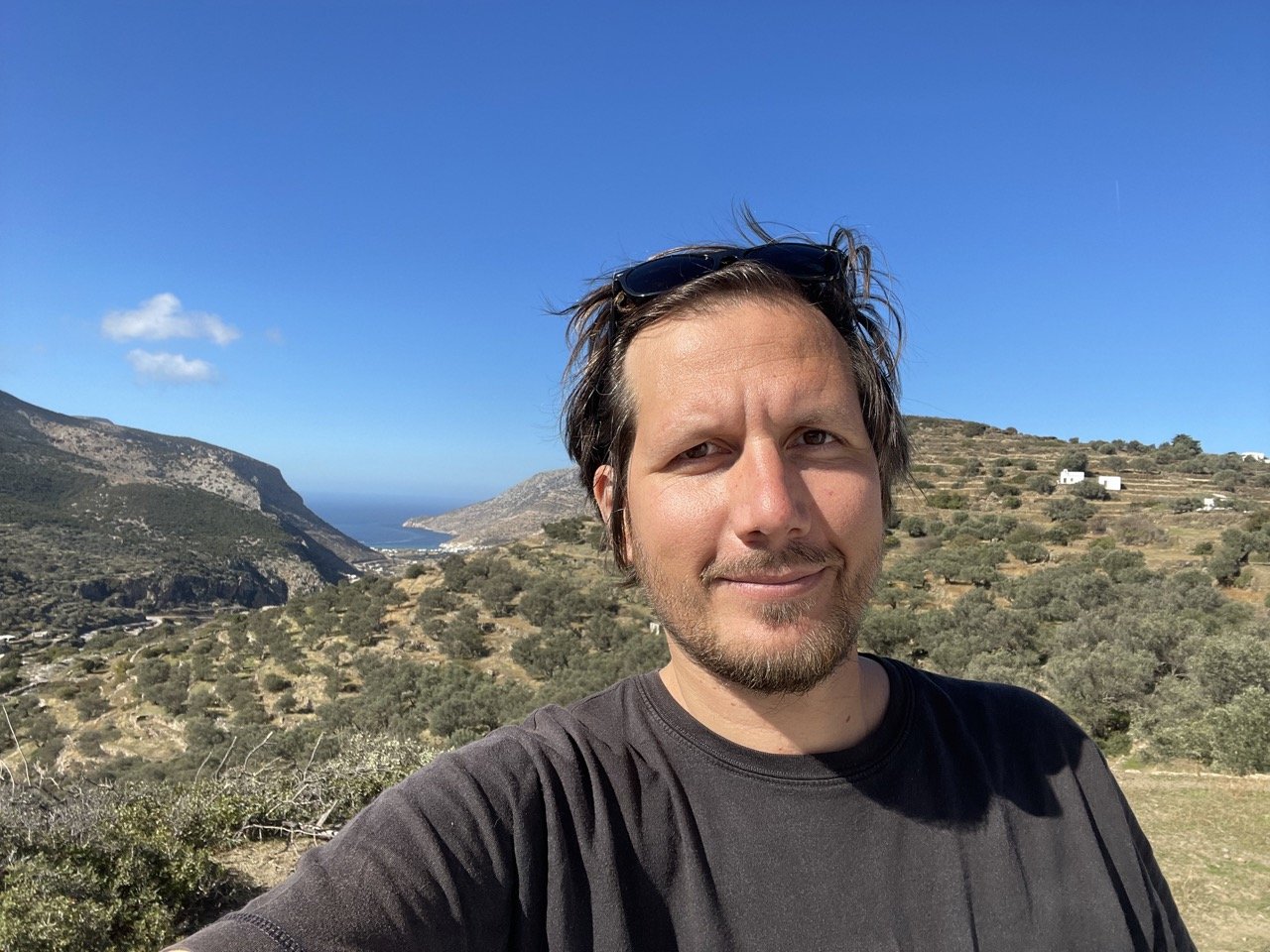
Connect with Luca
